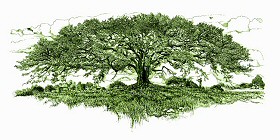| |
|
|
The Basics of Tree Pruning
MERISTEM
TIPS :: VASCULAR
SYSTEM :: TRANSPIRATION
:: THE 1/3 RULE
THE BRANCH COLLAR
:: TARGET PRUNING
:: CONCLUSION
:: GLOSSARY |
- adventitious
shoots limbs developing from places other than a meristem
tip. Adventitious shoots often form around a wound on the tree.
- angle
of emergence the slope between a leading branch and a limb
sprouting from it. Generally, a tight angle of emergence results in
weakened structures.
- anvil
the flat blade on a set of clippers. In proper pruning technique,
the anvil is positioned on the outboard side of the cut, away from
the tree.
- benign
neglect management system a method of care which allows a
tree to remain on its site with minimal interference from man.
- branch
collar the point at which a limb joins a leader or a lateral.
The branch collar represents the tree’s first line of defense
against decay, the arborist makes the final cut just outside the branch
collar when removing limb.
- callous
hard formation of tissue covering a wound
- cambium
layer the narrow zone of tissue in a stem that produces new
cells. The cambium layer also contains the vascular system, which
transports water and nutrients throughout the plant
- canopy
the uppermost leaves and branches of a tree or group of trees
- capillary
action the ability of a substance to draw another substance
into it. In plants, it is the ability to move liquid through the structure
as a result of surface tension.
- carbohydrates
organic compounds in living tissues including sugars, starch, and
cellulose. They fill numerous roles such as the transport and storage
of energy and structural components.
- catastrophic
embolism a blockage of the vascular system that causes the
plant to lose its ability to transport liquids. This is often caused
when air enters the system through a wound.
- cultivar
a plant variety that has been produced by selective breeding
- decomposition
organisms living substances such as fungi, bacteria, and
insects that break down plant matter
- egregious
shockingly bad, blatant
- epicormic
shoot limbs sprouting from a previously dormant bud
- excise
to cut out with surgical precision
genetic map the growth pattern typical of the hereditary characteristics
of a particular species - graft
a shoot inserted into a slit of a growing plant from which it receives
sap. Fruit trees are often formed by grafting a cultivar onto a hardier
root stock
- incision
a surgical cut
- lateral
a shoot or a branch growing from the side of a stem
- leader
a shoot of a plant at the tip of a stem or main branch
- meristem
tips the growing ends of shoots and roots that contain the
tissue that produces new cells in the plant. The meristem tips are
the only places where a plant elongates in form.
- morphology
the outward appearance (physical form, shape, external structure,
color, pattern) of an organism
- mulch
a layer of decaying organic matter such as leaves and bark, that enriches
and insulates the soil
- narrow
crotching structure a shoot or branch with a tight angle
of emergence from a stem, causing it to have a weak attachment.
- osmosis
the diffusion of liquid through a cell wall or membrane. Osmosis is
the means by which water and nutrients move through a tree
- parallel
leads two shoots growing in the same direction competing
for space in the canopy
- pathogen
a bacterium, virus, or other microorganism that can cause disease
- photosynthate
a sugar or other substance made by photosynthesis
- photosynthesis
the conversion of light energy into chemical energy by living organisms,
particularly green plants. The raw materials are carbon dioxide and
water, the energy source is sunlight, and the end products are oxygen
and carbohydrates.
- photosynthetic
prime one of the forces moving fluids through the tree.
- pollard
a cut that removes the top of a stem, causing shoots to form around
the base of the wound
- resprout
shoots that grow from the base of a wound
- root
crown the top layer of the mass formed by the roots of a
plant and the soil surrounding them
- root
crown shoot an adventitious sprout emerging from the root
system
- root
stock a plant, sometimes just a stump, which has an established,
healthy root system, used for grafting a cutting or budding from another
plant.
- sap
pressure osmotic force that moves the vital fluids through
a plant
- scaffold
the trunk and branch structure of a tree
- self
pruning the process in which a tree sheds unproductive limbs
without human interference
- shade-out
die back dead structures in the interior of the tree from
which the tree has withdrawn energy since they are no longer exposed
to sunlight
- shear
the sharp edged blade on a set of clippers. In good pruning technique,
the shear is placed toward the tree when a cut is made
- target
pruning an approach to tree management based on the removal
of structures that are interfering with the tree’s health or
are no longer productive for the tree
- transpiration
the evaporation of water through the aerial part of the tree, especially
the leaves. Transpiration enables the mass flow of mineral nutrients
and water from the roots to the shoots
- vascular
system the circulatory system of a plant that conducts water,
minerals, and nutrients
Click
here for more information and products for proper tree care, including
our comprehensive video Prune Like a Pro, available on this website.
<<
BACK<<
|
|



